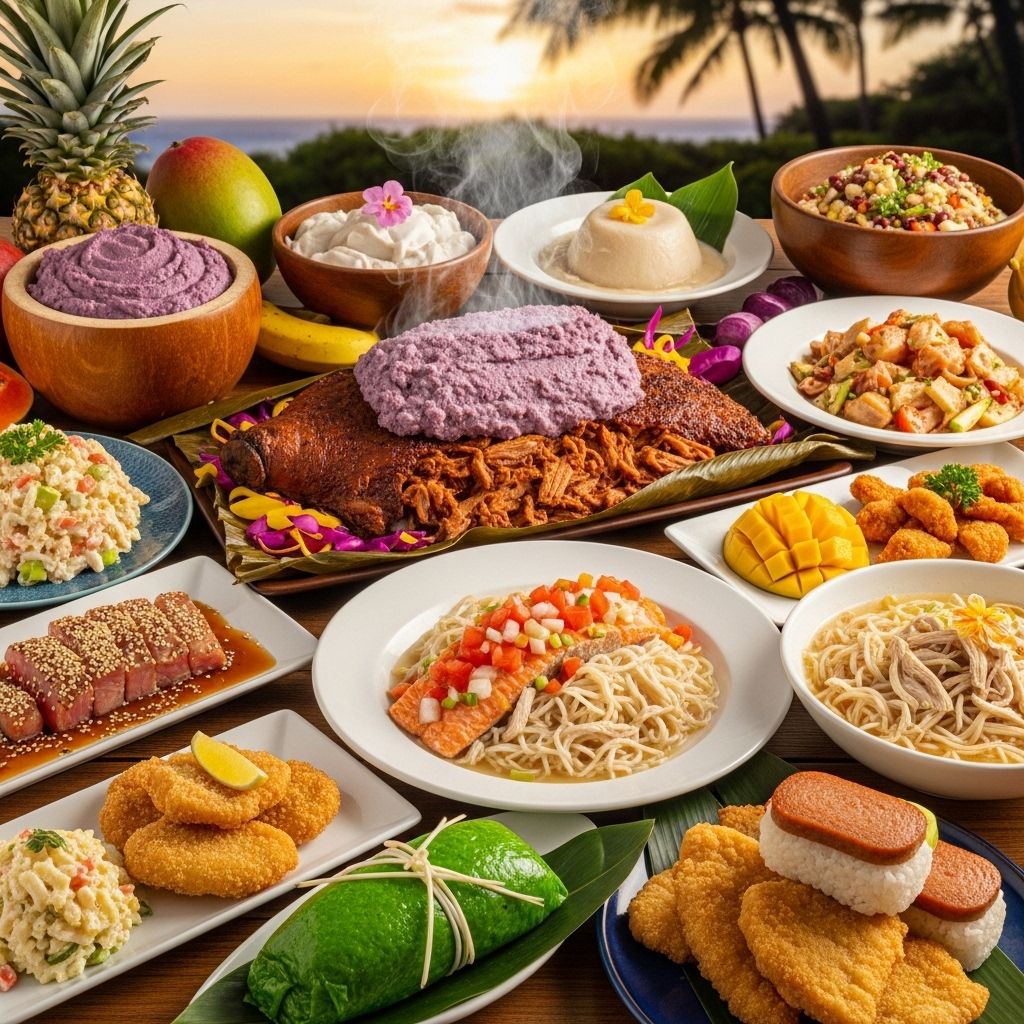Hawaiian Cuisine: 11 Iconic Local Dishes To Savor
Each recipe carries a tale of melting-pot heritage and age-old cooking rituals.

Hawaiian Cuisine: A Delicious Exploration of Local Foods
Hawaii is a land of sweeping beaches, lush mountains, and a vibrant mix of cultures—a heritage deeply reflected in its culinary scene. From ancient Polynesian traditions to more recent culinary inventions, the islands have developed a repertoire of dishes that combine local ingredients with influences from Japan, China, Portugal, and more. In this guide, we’ll delve into some of Hawaii’s most iconic local foods, exploring their history, ingredients, and enduring cultural significance.
The Foundation: Hawaii’s Vibrant Food Culture
To understand Hawaiian cuisine, begin with its remarkable multicultural foundation. Native Hawaiian culinary traditions have merged with the influences of immigrant groups over centuries, creating a diverse and flavorful food culture. Essential elements include local starches like taro and rice, proteins from the sea and land, and seasonings inspired by a global pantry. Today, dishes from distinct communities converge seamlessly as “local food.”
- Poi (taro root paste)
- Lau lau (protein wrapped in taro leaf)
- Kalua pig (smoky shredded pork)
- Poke (marinated raw fish)
- Lomi salmon (salted salmon salad)
- Saimin (local noodle soup)
- Spam musubi (rice and Spam sushi)
- Huli huli chicken (rotisserie chicken with sweet glaze)
Spam Musubi: Hawaii’s Ubiquitous Snack
No food symbolizes Japanese-American influence in Hawaii more than Spam musubi. Combining American canned luncheon meat with Japanese onigiri technique, Spam musubi is both portable and satisfying.
- Ingredients: A slice of grilled Spam atop a bed of steamed rice, wrapped snugly in nori (seaweed).
- History: Spam arrived in Hawaii during World War II and became a household staple.
- Popularity: Found everywhere—from gas stations and school cafeterias to high-end restaurants.
The secret to its enduring appeal? The savory-salty flavor of Spam, the tender rice, and the crisp nori combine beautifully, making it an anytime snack or meal.
Spam Musubi Variations
- Teriyaki-glazed Spam musubi
- Egg-added Spam musubi
- Furikake rice spam musubi (with Japanese rice seasoning)
Poke: Hawaii’s Signature Raw Fish Dish
Poke (pronounced “POH-keh”) is Hawaii’s answer to sashimi, yet uniquely Hawaiian. This raw, diced fish salad captures fresh island flavors—with a customizable finish.
- Traditional Base: Ahi tuna, sea salt, seaweed (limu), and sweet Maui onions.
- Modern Marinades: Shoyu (soy sauce), sesame oil, chili pepper, and other condiments.
- Texture: Tender, fresh cubes of fish tossed with crisp onions, creamy avocado, or crunchy nuts.
Poke is often served on its own, but the invention of the poke bowl—rice topped with a generous heap of poke and assorted toppings—has made the dish infinitely customizable and popular worldwide.
Types of Poke
- Limu poke: With seaweed (limu).
- Shoyu poke: Soy sauce-based.
- Spicy poke: With spicy mayo, chili oil, or sriracha.
Kalua Pig: Smoky Tradition From the Imu
Kalua pig is Hawaii’s iconic barbecue, slow-roasted in an imu (underground oven). The result: deeply smoky, tender shredded pork that anchors island feasts.
- Cooking Method: Pork shoulder or butt seasoned with salt, wrapped in ti leaves, then buried on hot rocks to steam for hours.
- Flavor Profile: Smoky, succulent, seasoned primarily by the earth and leaves.
- Context: Traditional at lūʻaus, often served alongside poi and other classic sides.
While you’ll still find authentic imu-roasted pork at cultural events, most modern restaurants use ovens, smokers, or slow cookers to replicate the flavor.
Lau Lau: Wrapped in Tradition
Lau lau is a Hawaiian classic—meat or fish enveloped in taro leaves (luau), steamed until velvety.
- Traditional Recipe: Pork or salted fish with fat, wrapped in layers of taro leaves, and steamed within ti leaves.
- Preparation: Often cooked in an imu (earth oven), lending smoky flavor and tender texture.
- Modern Variations: Chicken, fish, or vegetarian versions can be found today.
The taro leaves give a spinach-like, earthy taste, rich in nutrients and comforting in texture.
Lomi Salmon: A Refreshing Side
Lomi salmon combines cubed salt-cured salmon, fresh tomatoes, and onions for a cool, tangy salad.
- Ingredients: Raw tomato, white onion, and salted salmon.
- Flavor: Bright, savory, and reminiscent of chunky salsa.
- Role: Often served alongside richer poi and meats to balance flavors.
Poi: The Soul of the Islands
Poi is Hawaii’s foundational starch—a creamy purple paste made from pounded taro root and water.
| Poi Characteristics | Details |
|---|---|
| Texture | Smooth, stretchy, spoonable |
| Flavor | Mild, slightly sour (from fermentation) |
| Traditional Use | Main staple; eaten with meats and fish |
Poi is celebrated for its cultural significance and nutrition. While its taste is an acquired preference for visitors, locals often pair it with dishes like lau lau or kalua pig.
Saimin: Hawaii’s Own Comforting Noodle Soup
Saimin originated in Hawaii’s sugar plantation era, inspired by ramen, Chinese mein, and Filipino pancit traditions.
- Ingredients: Soft wheat noodles in a clear, dashi-style broth, garnished with green onions, kamaboko (fish cake), and slices of char siu (Chinese-style BBQ pork).
- Origins: Developed out of necessity—merging Japanese, Chinese, and Filipino cooking for affordable, nourishing meals.
- Modern Saimin: Sometimes topped with wontons, ham, or eggs.
You’ll find saimin at drive-ins, fine restaurants, and even McDonald’s in Hawaii, a testament to its popularity and adaptability.
Huli Huli Chicken: Sweet, Smoky Perfection
Huli huli chicken is a crowd favorite: rotisserie chicken glazed with a sweet-savory sauce of soy, ginger, garlic, and pineapple juice.
- Cooking: The name “huli huli” refers to turning (“huli” means “turn” in Hawaiian)—the chicken is constantly flipped on the grill, basting in its own juices.
- Taste: Sweet, smoky, and addictively flavorful from frequent basting.
- Best enjoyed: At fundraisers, roadside stands, or backyard barbecues.
Plate Lunch: Hawaii’s Everyday Feast
The plate lunch represents the bounty of hardworking Hawaii communities, consisting of generous portions and variety.
- Typical Components: Two scoops rice, macaroni salad, and a protein—beef, chicken, or fish.
- Roots: Emerged from laborers’ meals; now a staple at diners, lunch wagons, and takeout spots statewide.
- Popular Proteins: Teriyaki beef, katsu chicken, fried mahi mahi, kalua pig.
What sets plate lunch apart is the combination of Asian, American, and Hawaiian flavors and the generous portions: it’s filling, affordable, and deeply comforting.
Loco Moco: Hearty Island Comfort
Loco moco epitomizes local diner fare—caloric, savory, and utterly Hawaiian.
- Ingredients: White rice, hamburger patty, thick brown gravy, and a fried egg.
- History: Created in Hilo in the 1940s and quickly adopted throughout the islands.
- Adaptations: Swap for chicken katsu, ham, or even vegetarian patties.
Every bite delivers soft rice, flavorful meat, and rich gravy—perfect after a surf session or a long workday.
Shave Ice: Hawaii’s Sweet Refreshment
Shave ice is more than a dessert—it’s a cooling ritual after sun-soaked adventures. Fluffy, finely shaved ice is drenched in fruit syrups—sometimes topped with condensed milk or ice cream.
- Flavors include passionfruit (lilikoi), guava, mango, and pineapple.
- Often topped with mochi balls, azuki beans, or snow cap (condensed milk).
Other Local Favorites and Influences
- Malasadas: Portuguese-style deep-fried doughnuts rolled in sugar.
- Manapua: Oversized Chinese bao stuffed with char siu pork or sweet fillings.
- Mochi: Japanese rice treats, sometimes filled with sweet bean paste or ice cream.
- Chicken long rice: Chicken stewed with ginger and mung bean noodles.
- Luau stew: Taro leaves simmered with coconut milk and seafood.
The Cultural Significance of Hawaiian Food
The dishes of contemporary Hawaiian cuisine mirror the islands’ complex social history: Native Hawaiian practices blend seamlessly with Chinese, Japanese, Filipino, Portuguese, and American influences. Food is a medium for family gatherings, celebrations, and community fundraisers—anchoring social life and preserving cultural memory.
Dishes are passed down and adapted, reflecting not just what is available, but the prevailing creativity, resilience, and hospitality of Hawaii’s people.
Frequently Asked Questions (FAQs)
Q: Are these dishes available everywhere in Hawaii?
A: Yes, you’ll find most iconic foods across Hawaii—at restaurants, lunch wagons, convenience stores, and even food trucks. Certain specialties, like imu-style kalua pig, are most common at traditional lūʻaus.
Q: Is Hawaiian food spicy?
A: Most traditional Hawaiian dishes are not spicy, but chilies appear in some poke varieties and modern adaptations. Shoyu, sesame, ginger, and sweet flavors dominate.
Q: Can Hawaiian cuisine accommodate vegetarians?
A: Absolutely. Many dishes like saimin and poke have vegetarian versions, and sides like poi, lomi lomi tomato (without salmon), macaroni salad, and luau stew are meat-free.
Q: Where can I try these dishes?
A: Visit local Hawaiian restaurants, lūʻaus, farmers markets, school cafeterias, and roadside stands. Many chain stores and takeouts carry favorites like Spam musubi and saimin.
Q: What flavors should I expect in Hawaiian cuisine?
A: Expect a mix of savory (soy, salt), sweet (pineapple, teriyaki), earthy (taro, ti leaves), smoky (kalua pig), and tangy (tomato, onion, lime). Texture is equally important—creamy poi, crunchy vegetables, and tender meats abound.
Conclusion: Eating Hawaii—A Culinary Journey Through Cultures
Exploring Hawaiian cuisine means tasting a living mosaic of cultures and flavors. From humble beginnings to international acclaim, local food in Hawaii goes beyond sustenance: it tells the story of the islands and the bonds between people who call Hawaii home. Whether you’re a first-time visitor or lifelong resident, these dishes are an invitation to savor tradition, innovation, and the spirit of aloha.
References
- https://en.wikipedia.org/wiki/Cuisine_of_Hawaii
- https://migrationology.com/traditional-hawaiian-food-dishes/
- https://naleialoha.com/introduction-to-hawaiian-cuisine/
- https://www.hawaiianairlines.com/hawaii-stories/culture/how-to-eat-hawaiian-food
- http://www.deviatingthenorm.com/blogarchive/2017/4/13/hawaiian-food-what-to-eat-and-where-on-oahu
Read full bio of Shinta












